For students returning to campus or learning to navigate the Hilltop for the first time, one thing is immediately obvious: construction is everywhere.
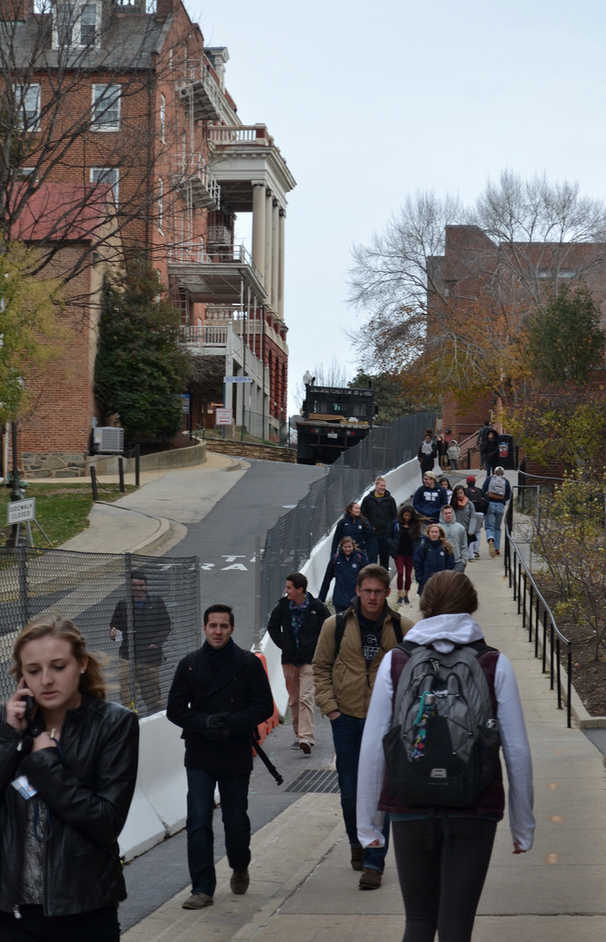
Crowded walkways are all that Georgetown students have known in the past year.
Detours continue to redirect foot traffic and cause bottlenecks, affecting the Reiss Pathway, Library Walk, Henle Village, Tondorf Road, and McDonough Arena. The paths crossing Georgetown’s 104-acre campus wind around several of these ongoing construction projects, the most visible reminders of the 2010 Campus Plan.
The agreement between the neighbors and the university that called for housing 90 percent of students on campus by 2025, and that outlined all construction projects going forward through 2017, left a bitter taste among students and in the neighborhoods surrounding campus. Since then, the development of the Georgetown Community Partnership (GCP) has opened up conversations between stakeholders as the foundations begin to take shape for the next Campus Plan, which will last until 2038.
“The campus plan will determine every facet of the university’s growth for the next 20 years,” said Ari Goldstein (COL ‘18), GUSA Secretary of Campus Planning. As effects of students living off-campus on their neighbors continue to raise concerns, and as construction continues to crowd campus and reroute foot traffic, students have a valuable role to play in shaping the Hilltop for future Hoyas.
A university in an area that is zoned as residential, Georgetown is obligated to submit a campus plan to the D.C. Zoning Commission each decade. The plan covers physical and enrollment growth, and is required to address ways in which the university will mitigate “objectionable impacts” on the surrounding community.
When the plan is submitted to the Zoning Commission, the surrounding area’s Advisory Neighborhood Commissions(ANC) vote on whether to approve the plan, and, along with neighborhood organizations, can submit their positions to the Commission for consideration. District government agencies legally must give “great weight” to these submissions and respond directly to any arguments raised.
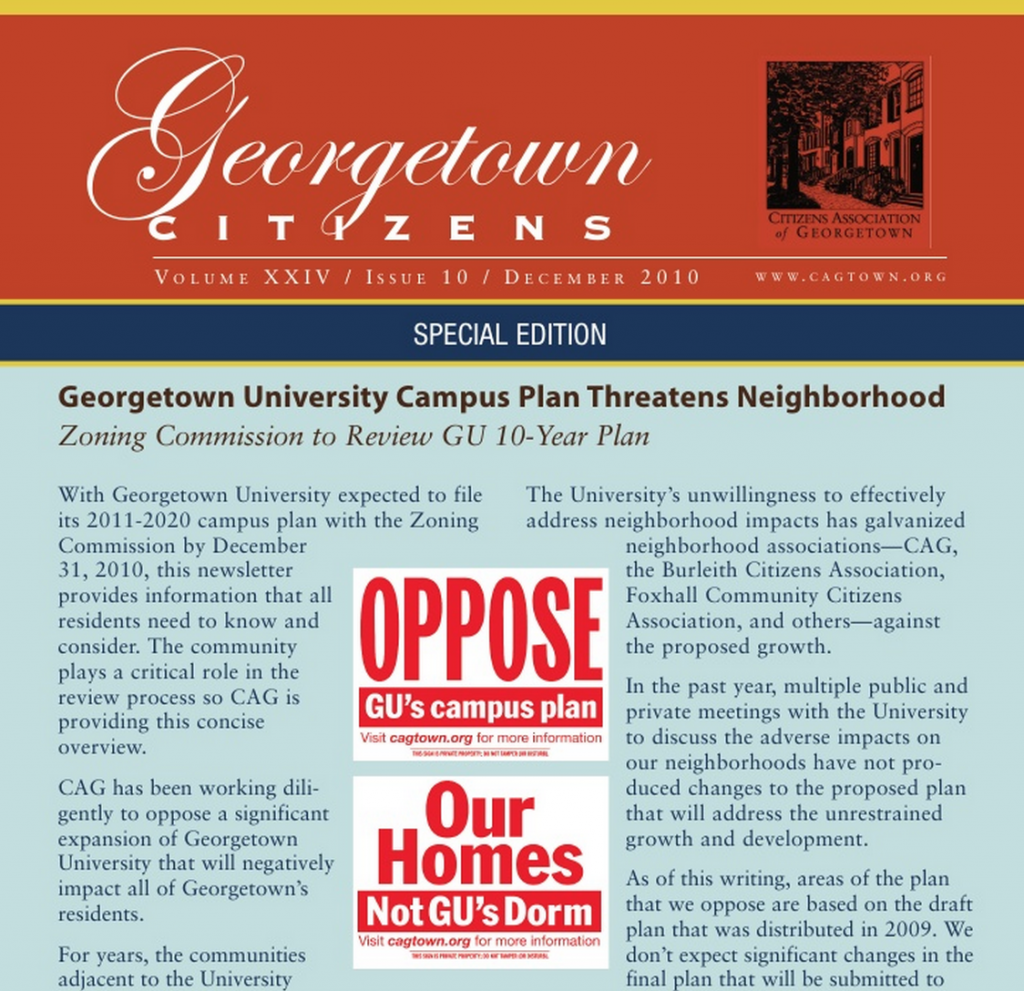
The Citizen’s Association of Georgetown Dec. 2010 newsletter opposing the campus plan, from the days of more bitter town-gown relations.
In 2010, the Zoning Commission rejected Georgetown’s proposal, after it faced opposition from ANC 2E, the Advisory Neighborhood Commission for Burleith, Georgetown, and Hillandale. Other neighborhood groups, including the Citizens Association of Georgetown and the Burleith Citizens Association, also challenged the plan, and urged the ANC and Zoning Commission to reject it. The tone was adversarial at times, with signs throughout the neighborhoods protesting the plan and negotiations between stakeholders lasting for more than two years before the final plan was approved.
[pullquote]“We’re on track towards not getting screwed again.”[/pullquote]
In the wake of that dispute, the GCP was formed in 2012 as part of the final Campus Plan agreement, with the goal of bringing all stakeholders into the conversation during the next plan’s development to minimize the likelihood of similar conflicts. ANC Commissioners, neighborhood leaders, members of the university administration and several on-campus departments, representatives of the Medstar Georgetown University Hospital (MGUH), and students sit on the steering committee and working groups of the partnership.
The plan that the university will submit in 2018 will guide future decisions similar to those currently visible on campus as the result of the previous campus plan.
“When you look at the campus, and you see construction, you see the residence halls, you see the addition of the third year living requirement, you see tightened student conduct policies, all of that was the result of the last campus plan,” Goldstein said.
With that in mind, administrators and neighbors alike are approaching the process this time with a more positive outlook. The GCP meetings occur behind closed doors, according to Goldstein, and many of the representatives contacted declined to share specific initiatives and priorities going forward. However, they expressed optimism in the progress made so far in shaping priorities and their goals in the future.
As they were in 2010, quality of life issues remain a top priority for all interested parties. For students, an obvious concern is the state of campus, including the quality of facilities and the on-campus living requirement.
“Our goal at the end of the day is to make the university a living-learning community which provides students with an incredible undergraduate experience in and out of the classroom (in other words, a youtopia),” GUSA President Joe Luther wrote in an email to the Voice, referencing the campaign that he and Vice President Connor Rohan ran. “An example of such an issue would be deferred maintenance of dorms and apartments. Many students have experienced incredibly sub-optimal living situations on campus and many on-campus housing options remain years behind schedule for repairs.”
The university’s master planning website also highlights this issue, specifically noting Henle as needing renovations. According to the Master Planning blog, however, a timeline for those improvements has not yet been finalized. Administrators included these renovations among their priorities for the 2018 Campus Plan, as part of improving the “living learning community” of campus as a whole.
“We’ve had a number of conversations over the summer … including what are the qualities we’re looking for in future housing, what are some of the concerns around the quality of our current housing, and how do we move in a direction that helps improve that,” said Dr. Todd Olson, Vice President for Student Affairs.
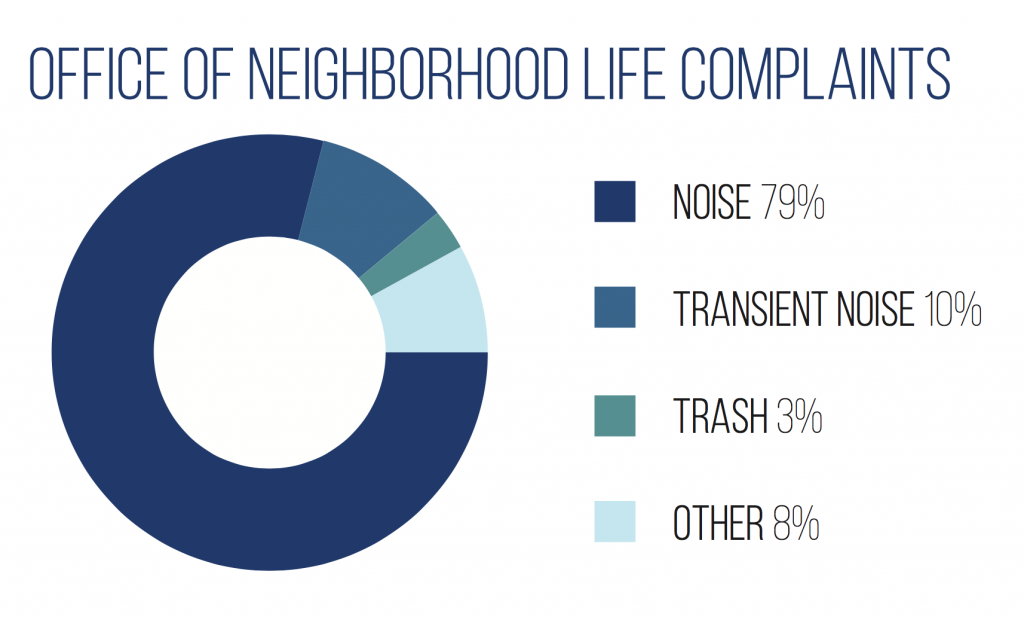 Long-standing issues in the neighborhood, such as trash and noise at off-campus student houses, as well as congestion and traffic, are also ongoing concerns for residents in Burleith, Georgetown, and Foxhall. These fall under the category of “objectionable impacts” that the university is obligated to minimize, and will continue to be a focus in the planning process, particularly within GCP working groups.
Long-standing issues in the neighborhood, such as trash and noise at off-campus student houses, as well as congestion and traffic, are also ongoing concerns for residents in Burleith, Georgetown, and Foxhall. These fall under the category of “objectionable impacts” that the university is obligated to minimize, and will continue to be a focus in the planning process, particularly within GCP working groups.
During the 2014-2015 academic year, the Office of Neighborhood Life (ONL) addressed 488 total contacts, which include SNAP, GUPD and MPD interacting with students and non-student residents, both proactively and through the ONL helpline, according to the Division of Student Affairs. Seventy-nine percent of the contacts were related to excessive noise at an off-campus property.
ANC 2E Commissioner Ed Solomon, who co-chairs the partnership’s Safety and Student Life working group with GUPD Chief Jay Gruber, said that this issue has been improved in recent years. “I see a remarkable decline in noise. Complaints [from neighbors] have dropped remarkably, so I’ve got nothing but positive things to say about how that committee has been working together,” he said.
Another key feature of the planning principles is the development of a proposed “Student Life Corridor,” which would include building an additional dormitory between Village C West and Harbin Hall, and increasing student living and social spaces along the road between the Leavey Center and the Healey Family Student Center, according to the Master Planning website.
These potential additions and the possibility of increasing on-campus housing have also been central to recent GUSA deliberations. “The largest flash point in our conversations with GUSA have been about housing, and swing space, and what the future of all that looks like,” Goldstein said. He named “no additional on-campus living requirements, prioritizing renovations [and] fair off-campus conduct policies, ” as among his goals going forward.
The goal of housing 90 percent of students on campus by 2025, which has directly contributed to the need for construction of the new residence halls, was also a major issue for students and neighbors alike in the 2010 Campus Plan. The percentage of students living in surrounding areas is still part of the ongoing conversation about neighborhood life.
[pullquote]“Our goal at the end of the day is to make the university a living-learning community which provides students with an incredible undergraduate experience in and out of the classroom (in other words, a youtopia)”[/pullquote]
“I’ve never been a proponent of 100 percent on campus,” said ANC 2E Commissioner Jeffrey Jones, who supports the 90 percent goal. “I think we’re at the right number right now.”
Jennifer Altemus (COL ‘88), Vice President of the Citizens Association of Georgetown, who led the charge in the “Our Homes, Not GU’s Dorms” campaign in 2011, is also supportive of the limitations on off-campus housing.
“We’ve already seen that there are more vacancies in the neighborhood where there used to be student group houses, and hopefully those will turn into single family homes, and it’ll be great for the neighborhood,” she said. “I don’t know [about 100 percent of students on campus], we haven’t really talked about that. I’d like to see how the 90 percent goes and maybe take it from there.”
The GCP steering committee and working groups will continue to address these concerns, according to Olson and Jones, who identified these quality of life issues as priorities going forward.
The GCP’s steering group and working groups, which range from Safety and Student Life to Transportation and Parking, meet regularly to discuss concerns and solutions, and the groups aim to bridge the gap between the university and community to highlight common priorities. The increased communication is also intended to address issues during the planning process, rather than after it is submitted to the Zoning Commission.
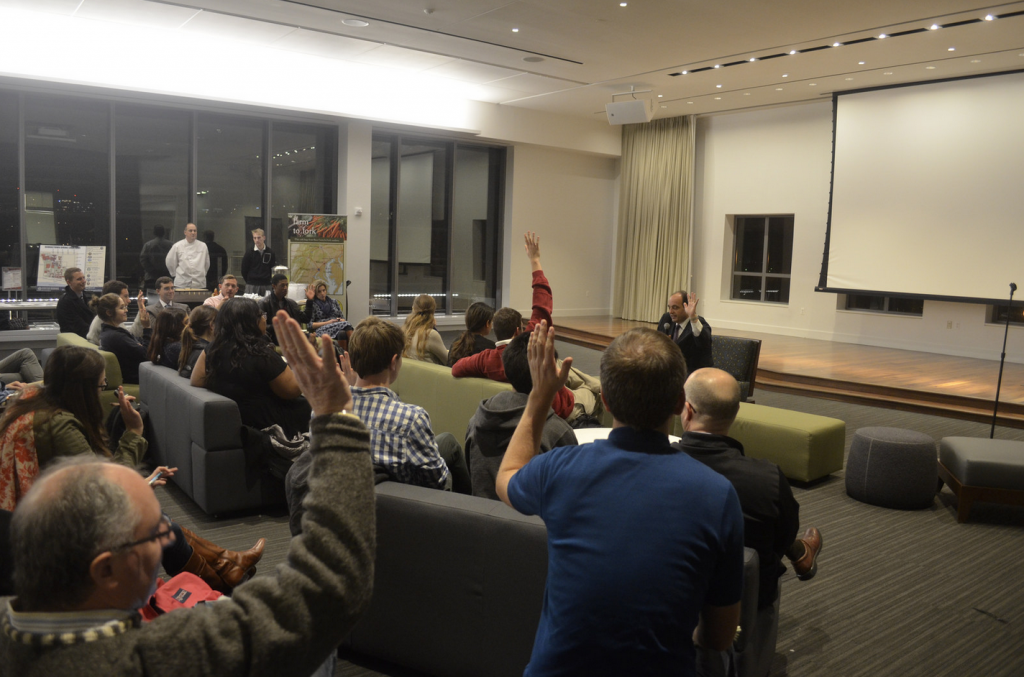
Hoya Roundtable at the Healey Family Student Center.
“I think it’s collaborative planning at its best, when all of the stakeholders are represented, and I would say that that’s pretty new and different than prior campus plans,” said Robin Morey, the university’s Vice President for Planning and Facilities Management. He cited the ongoing conversations between students, university and MGUH administrators, and neighbors that are facilitated within the GCP as a key component of the changed tone.
This is a stark contrast from the previous campus plan, when neighbors felt that the plan failed to adequately address the objectionable impacts that they experienced in the neighborhoods surrounding campus.
In a 2011 supplemental submission to the Zoning Commission opposing the 2010 Campus Plan, Solomon wrote that “based on extensive past experience over the years as well as recent experience, neither my neighbors nor I believe that the University can or will keep things quiet over the long run. The Burleith community and I have heard rosy predictions about this before from the University, and it never has worked.”
When asked about the status of these objectionable impacts in 2015, Solomon reported a much higher level of satisfaction overall.
“I’ve gotten to know a lot of the students as well,” he said, citing the ongoing communication as an improvement. “I think there’s a lot of potential, and I’m sure the partnership is going to continue. It’s very healthy, and it’s going to continue well into the future,” he said, a far cry from his lack of faith in the university’s future actions four years ago.
[pullquote]“I think it’s collaborative planning at its best, when all of the stakeholders are represented, and I would say that that’s pretty new and different than prior campus plans.”[/pullquote]
Students likewise have been optimistic about their increased role in the process, including the addition of two seats on the steering committee for student ANC Commissioners Kendyl Clausen (SFS ‘16) and Reed Howard (SFS ’17).
Luther, who was involved in meetings throughout the summer, highlighted this increased student representation as a key factor in the partnership’s success thus far.
“The additional representatives on the GCP steering committee are an important step in legitimizing student input at every step of this campus plan process,” Luther wrote. “This move creates a GCP in which students are now able to be players on both the working group and steering committee level. In creating the next campus plan, this will be critical in crafting a document which is responsive to student needs.”
That’s not to say that the issues that caused such contention in the previous Campus Plan and contributed in part to the ongoing construction and disruption on campus have disappeared. However, many have claimed that the process of addressing these disputes has improved.
“It’s a misperception, though, that things are perfect,” Jones said. “Things aren’t perfect, we’re not in a perfect world. You know, I think we’re just going to have to continue the dialogue.”
As the stakeholders hope to achieve a consensus on a basic framework this winter, the coming months will be critical in shaping the framework of the Campus Plan, according to Goldstein. GUSA will create a student master planning consortium to solicit input from students regard- less of whether they are in GUSA.
“The administration will continue to have Hoya roundtables and master planning sessions. Those are really important to show up to talk with administrators, to voice concerns, to ask questions. Right now we’re really trying to streamline, focus and expand those so it’s very clear to students this fall how they can jump into the process,” Goldstein said.
The university’s master planning site also includes resources that students can access. ANC Commissioners and GUSA members alike also encouraged students to contact them directly with concerns or to express interest in getting involved.
“We’re on track towards not getting screwed again,” said Goldstein, in reference to GUSA’s spring campaign to mobilize voices on the issues. “The administration is receptive, there is a general atmosphere of collaboration that didn’t exist in 2010. If everyone continues the way they have been operating over the past few years, the plan will hopefully be equitable and effective. But we can’t rest. The only reason we have a seat at the table now and the only reason things are better than they have been is because students have spoken up loudly to demand that.”
Editor’s note: This article has been corrected to reflect the requirements of the 2010 Campus Plan. The Plan required Georgetown University to provide 385 new on-campus beds by the fall of 2015, with the long term goal of housing 90% of undergraduate students on campus by 2025.


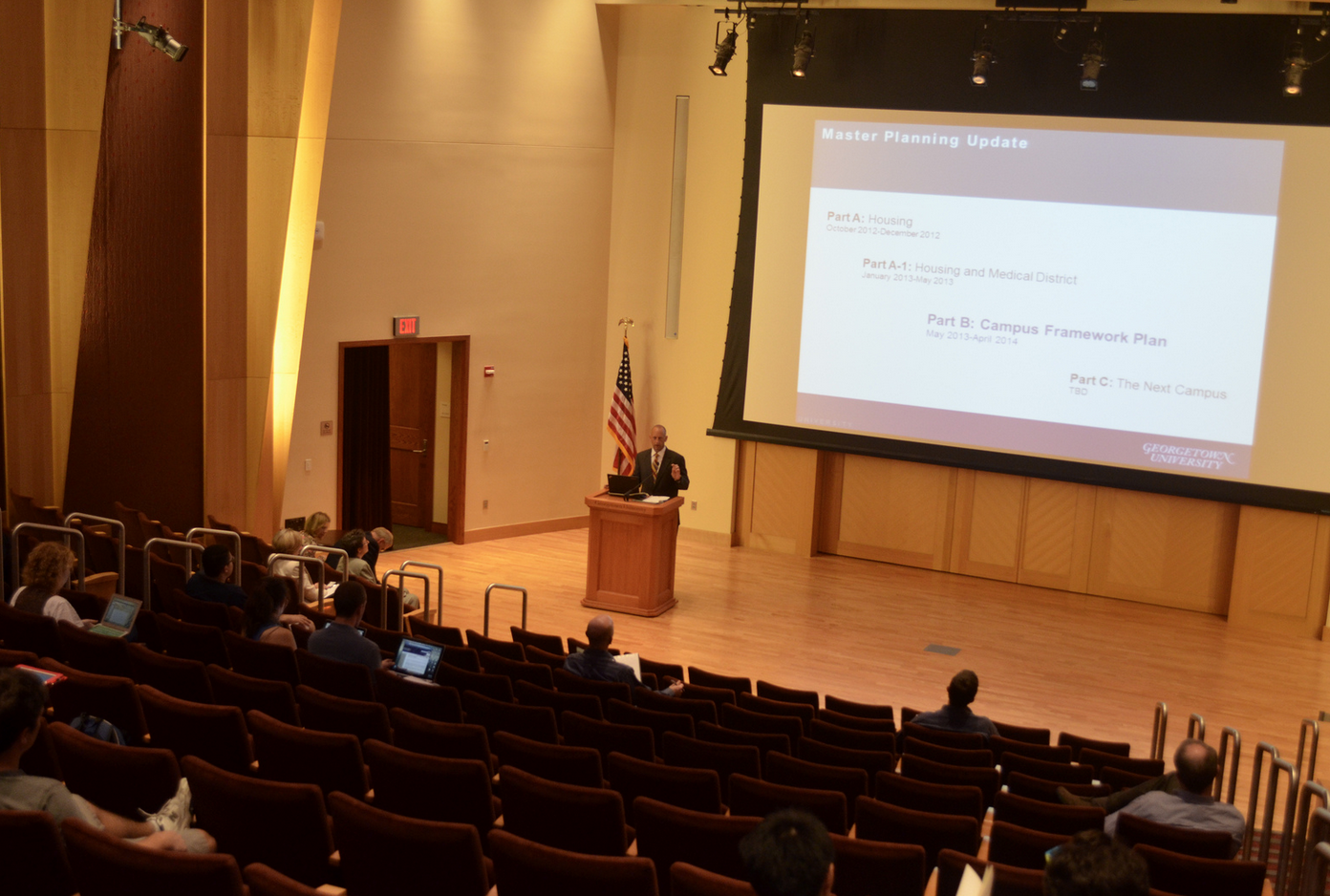



The 2010 campus plan did not call for 90% of students on campus. That number is not in the campus plan. It mandated that roughly 86.3% of students live on campus, and while it brought more beds on campus, the number is not close to 90%.
[…] D.C., requires all universities in an area that is zoned as residential, (i.e. Georgetown) to submit a campus plan to the D.C. Zoning Commission for approval each decade. The plan covers […]